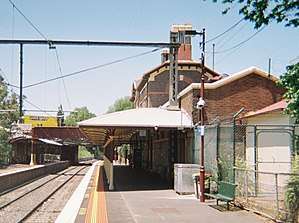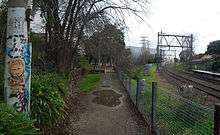Windsor railway station, Melbourne
Windsor railway station is located on the Sandringham line in Victoria, Australia. It serves the south-eastern Melbourne suburb of Windsor opening on 19 December 1859 as Chapel Street, being renamed Windsor on 1 January 1867.[2] It is listed on the Victorian Heritage Register.[3]
Windsor | |||||||||||
|---|---|---|---|---|---|---|---|---|---|---|---|
 | |||||||||||
| Location | Chapel Street, Windsor | ||||||||||
| Coordinates | 37°51′22″S 144°59′31″E | ||||||||||
| Owned by | VicTrack | ||||||||||
| Operated by | Metro | ||||||||||
| Line(s) | Sandringham | ||||||||||
| Distance | 7.49 kilometres from Southern Cross | ||||||||||
| Platforms | 2 side | ||||||||||
| Tracks | 2 | ||||||||||
| Connections | Tram | ||||||||||
| Construction | |||||||||||
| Structure type | Ground | ||||||||||
| Other information | |||||||||||
| Status | Host station | ||||||||||
| Station code | WIN | ||||||||||
| Fare zone | Myki zone 1 | ||||||||||
| Website | Public Transport Victoria | ||||||||||
| History | |||||||||||
| Opened | 19 December 1859 | ||||||||||
| Electrified | Yes | ||||||||||
| Traffic | |||||||||||
| Passengers (2008-2009) | 0.966 million[1] | ||||||||||
| Passengers (2009-2010) | 1.025 million[1] | ||||||||||
| Passengers (2010-2011) | 1.067 million[1] | ||||||||||
| Passengers (2011-2012) | 1.067 million[1] | ||||||||||
| Passengers (2012-2013) | Not measured[1] | ||||||||||
| Passengers (2013-2014) | 1.054 million[1] | ||||||||||
| Services | |||||||||||
| |||||||||||
Platforms & services
Windsor Station has two side platforms. It is serviced by Metro Trains Sandringham line services travelling between Flinders Street and Sandringham.[4] Platform 1:
- Sandringham line: all stations services to Flinders Street
Platform 2:
- Sandringham line: all stations services to Sandringham
Transport links
Yarra Trams operate three routes via Windsor station:
- 5: Melbourne University - Malvern station[5]
- 64: Melbourne University - East Brighton[6]
- 78: North Richmond - Balaclava [7]
Link to St Kilda
The station was the terminus for trains on the Brighton Beach line, which was built in 1859 and operated by the St Kilda and Brighton Railway Company. The Company also built the loop branch line connecting the Brighton line to the Melbourne to St Kilda line, which was opened in 1857.
Trains from Melbourne travelled to the St Kilda terminus, and then "backed out" onto the branch line to Windsor. The loop line was constructed on wooden trestles across the swampy grounds now known as the Albert Park Lake, and had a raised embankment with a bridge[8] over St Kilda Road. The first train on this loop line was on 3 December 1859, and opened to the public ten days later. There were no trains after 7pm on the branch line; patrons simply walked to their homes in Prahran from St Kilda station in Fitzroy Street.
A short time after the loop line was constructed a competing connection was built between Windsor and South Yarra stations, the first train arriving at Windsor directly from Melbourne on 24 November 1860. The loop line to St Kilda soon fell into disuse, and track duplication, a condition of the original crown lease, was never completed.
| Preceding station | Disused railways | Following station | ||
|---|---|---|---|---|
| St Kilda | St Kilda - Windsor railway line | Junction | ||
| List of closed railway stations in Melbourne | ||||
Sidings
The St Kilda and Brighton Railway Company experienced financial difficulties and was bought by the Melbourne and Suburban Railway Company in 1862. The track, bridge and trestles between St Kilda station and Punt Road were dismantled; however, a siding from Windsor to Hoddle Street remained. Due to the track alignments there were now two level crossings within 100 metres on Union Street, as the siding continued to be used for shunting trains from the Brighton line, and to carry screenings from the Richmond quarries to a commercial depot on Punt Road (then known as Hoddle Street).
Perversely, it was due to local annoyance at the siding level crossing near the station, that trains won the legal right-of-way at road-rail intersections in Victoria. Indignant at the delays to horse-drawn traffic caused by trains, and in particular the perpetually closed and unmanned crossing of the siding, one morning in 1869, local councillors from Prahran marched to the level crossing in question with a group of workers who then began to rip up the tracks on the siding. The matter was later brought to court on 17 April 1869, although the railways won the right-of-way case, the siding was not reconstructed.
No evidence of the bridge over St Kilda Road or embankments remain, although the alignment of the loop can be traced by the residual parkland and in some cases, oddly shaped property boundaries. A small park to the west of Windsor station is called "Windsor Siding".
1887 accident
On the evening of 11 May 1887, an express train crashed into the rear of a passenger train between Prahran and Windsor stations. Four people were killed and over 100 severely injured. The locomotive of the passenger train stopped to await a semaphore signal that indicated the line ahead was clear. When the signal was given, the driver found he could not release the brake on the locomotive due to a ruptured steam pipe. An express train from Melbourne was scheduled 10 minutes behind the passenger train, and due to a curve in the track and high embankments had no way of knowing the train ahead was stranded. Cooper (1924) reported that the noise of the impact could be heard throughout Prahran, and that in a short time over 10,000 people were gathered at the site.[9] The driver of the Brighton express was Frederick William Maskell, who only weeks earlier, had received from the Commissioners a special reward of £5 for conspicuous and alert and intelligence in adverting an accident due to signal failure. Others killed were his fireman James Houston McNab and William Runting aged 21 and Annie Foster aged 45 of Colac.[10]
Gallery
 Windsor Siding reserve in June 2008
Windsor Siding reserve in June 2008
References
- "Train Station Patronage FY2008-2014" (XLS). Public Transport Victoria. 14 May 2015. Archived from the original on 30 March 2016. Retrieved 1 November 2016. (access from )
- Windsor Vicsig
- Windsor Railway Station Complex Department of Transport, Planning & Local Infrastructure
- "Sandringham Line". Public Transport Victoria.
- "5 Melbourne University - Malvern". Public Transport Victoria.
- "64 Melbourne University - East Brighton". Public Transport Victoria.
- "78 North Richmond - Balaclava via Prahran". Public Transport Victoria.
- http://www.stonnington.vic.gov.au/library/praimage/09/9303.jpg
- Cooper JB (1924) "History of Prahran" pp179–188, p286
- "Terrible Railway Accident". The Age (Melbourne, Vic.). Melbourne: John Fairfax & Sons. 12 May 1887. p. 5. Retrieved 9 June 2013.
External links
- Melway map at street-directory.com.au